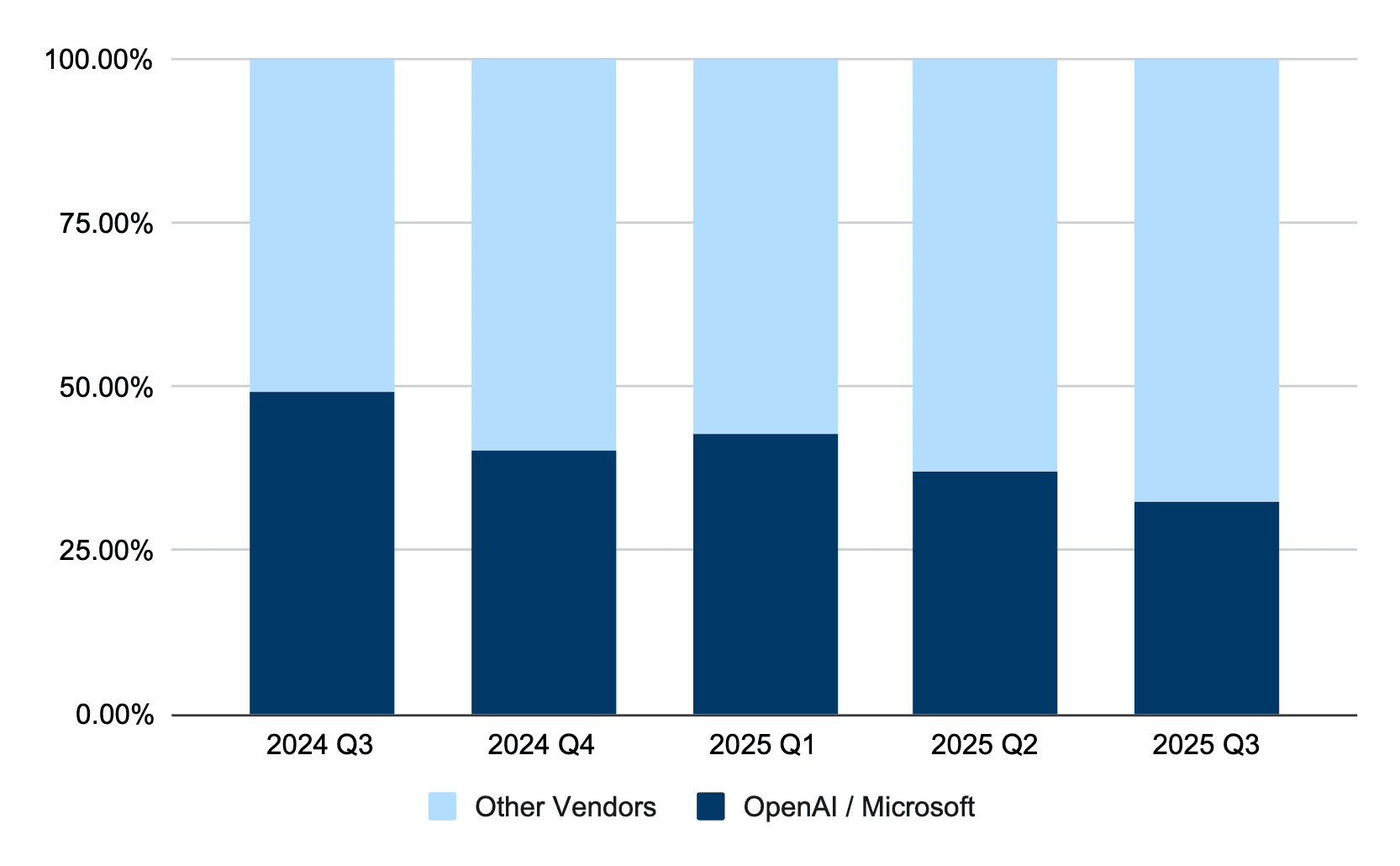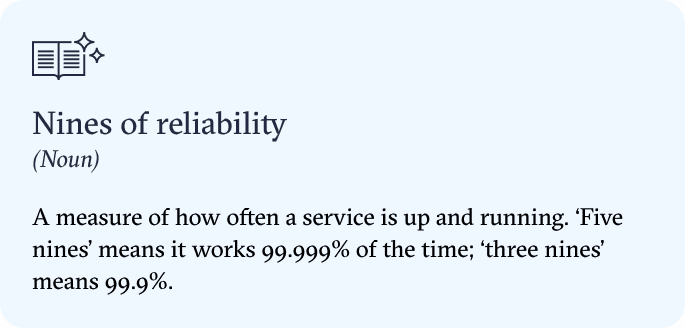
DATA-DRIVEN INSIGHTS AND NEWS
ON HOW BANKS ARE ADOPTING AI
Who's afraid of neobanks

Source: Adobe Firefly
16 October 2025
This week, a special look at digital banks. Why now? With booming valuations they’re mulling big expansions. Their looser approach to using technology has lessons for the old primes. Our usual Use Case Corner is also devoted to them.
Also, the first banks out of the gate on quarterly earnings address the AI bubble. Our Welcome to the Jargon entry grapples with big AI labs’ growing reliability problem. And don’t miss our conversation with FICO’s Scott Zoldi about a novel approach to AI risk management.
ICYMI: The Evident roundtable yesterday on the 2025 Index can be watched here. Next week, we’re on the ground in New York for the Evident AI Symposium. Want to tune in? Register for the livestream.
People mentioned: Jamie Dimon, David Solomon, Glenn Schorr, Jeremy Barnum, Jane Fraser, Sathish Muthukrishnan, Scott Zoldi, Daniele Magazzeni, Donald Patra, Ashwin Sinha, Christophe Rougeaux and Shelley Malton.
And these banks: Goldman Sachs, JPMorganChase, Ally Financial, Revolut, Nubank, Barclays, PNC, HSBC, Starling Bank, ANZ, TD Bank and NatWest
This edition is 2,385 words, a 6 minute read. Check it out online. If you were forwarded the Brief, you can subscribe here. We want to hear from you. Write us: [email protected].
– Alexandra Mousavizadeh & Annabel Ayles
FROM THE EVIDENT AI INDEX
OPENAI'S MARKET SHARE FALL
The share of use cases featuring the ChatGPT maker at the 50 banks we track has been cut by one-third in the last year.

At the end of last year, OpenAI was by far the leading vendor included in bank use cases (see: “4 use case trends for 2025,” The Brief, Jan. 9). No more, according to new data from the Evident Use Case Tracker.
The ChatGPT maker is mentioned in one-third of the use case announcements that include vendors, down from 49% a year ago. What’s going on? Cloud providers like AWS and Google are striking deeper partnerships with banks, offering them ways to access models from loads of providers instead of being locked into just one (See: “Banks play model field,” The Brief, May 29). Banks are also hitching their wagons to other, more-specialized vendors for specific use cases.
Want to know more about the specific ways banks are rolling out AI? Check out our Use Case Tracker – the inventory of all the AI use cases announced by the world’s largest banks available to members.

On 23 October 2025, we’re back in New York City for the flagship Evident AI Symposium, an annual gathering of the most senior AI movers and shakers in financial services.
See the full agenda featuring AI leaders including:
- Hari Gopalkrishnan, Chief Technology Officer, Bank of America
- Foteini Agrafioti, SVP, Data and AI and Chief Science Officer, RBC
- Prem Natarajan, Chief Scientist & Head of Enterprise Data & AI, Capital One
- Jodie Wallis, Global Chief AI Officer, Manulife
- David Griffiths, Chief Technology Officer, Citi
- Manuela Veloso, Head of AI Research, JPMorganChase
- Leigh-Ann Russell, Chief Information Officer, BNY
- Greg Ulrich, Chief AI and Data Officer, Mastercard
- Jonathan Pelosi, Head of Financial Services and Insurance, Anthropic
- And many more
TOP OF THE NEWS
MORE COWBELL
Beware the AI bubble! But there’s a way to protect yourself, say the CEOs of America’s biggest banks: Spend on AI.
Even as Goldman Sachs reported a 42% increase in investment banking fees this week, the firm unveiled a new plan called OneGS 3.0 that anticipates possible downturns by doubling down on AI to get leaner. CEO David Solomon’s intention to use the technology to simplify the way the bank’s businesses work together and eventually shed jobs from newly-squeezed efficiencies is something that a struggling company would do. Evercore’s Glenn Schorr pointed out as much on the analysts’ call, and Solomon shot back that his job is to grow earnings “whether it’s good times or bad.” Sounds like Solomon is using AI to build Goldman a doomsday bunker.
In their quarterly results call, JPMorganChase hit a similar note. Amid the victory lap of beating income expectations by $1 billion, CFO Jeremy Barnum preached “old fashioned expense discipline,” saying the bank would resist the urge to hire in flush times. That’s good insurance at a time of “heightened uncertainty” for the economy, to use CEO Jamie Dimon’s phrase. But Dimon’s bigger announcement this week also sees the bank doubling down on the future world of AI beyond the bank’s walls – a different kind of insurance policy. Its $1.5 trillion spending package focuses investment on four industries primed to be transformed by the tech, which could shift some of the U.S. economy’s growth away from just a few AI companies.
NOTABLY QUOTABLE
“The U.S. continues to be a pace setter, driven by consistent consumer spending as well as tech investments in AI and data centers. That said, there were pockets of valuation frothiness in the market.”
– Jane Fraser, CEO at Citi, during earnings, Oct. 14
TREND LINES
BRAVE NEO WORLD
There’s something about neobanks these days.
Revolut is now more valuable than Barclays, serves more customers than HSBC and has SocGen’s former CEO leading international expansion. Brazil’s Nubank is valued higher than PNC and is pushing into the U.S. Digital-only Ally Financial is now the U.S.’s 26th-largest bank by assets.
Long dismissed as upstarts who’ll never pose a serious challenge to legacy players, digital banks are riding the AI wave to get noticed. As Wall Street rewires itself around AI, these new players seem wired for the tech from the get-go. Whether they become the next primes or not, their approach bears a closer look.
Take Ally. The branchless lender is stacked with AI talent: The number of AI-focused employees relative to its size is on par with the top 10 banks in the 2025 Evident AI Index. Its data is primed to capitalize on the tech: 98% of it is centralized, and 95% of its apps are on the cloud – making it “discoverable, accessible, and readable” for AI according to chief information, data and digital officer Sathish Muthukrishnan. This summer, Ally used that infrastructure to push its generative AI platform firmwide (see: “Multitooling,” The Brief, Aug. 7), which sprawling banks struggle to do.
Revolut is much the same. Last month, the neobank posted jobs to build agentic AI tools that could do outbound sales or handle customer complaints. When big firms go agentic, much of their time is spent threading the needle on governance and figuring out how to hook flashy tech into old systems (see: “Where’s the agentic beef,” The Brief, Oct. 2). The 13,000-person neobank has cloud-native infrastructure, which means they’re not saddled with as much of that legacy tech debt and can develop agentic tools “from the ground up,” as the job descriptions put it.
In Brazil, Nubank built its own foundation models – something that only a handful of big banks have even attempted – in eight months (more on that below). Building these reusable models lets the bank easily and quickly plug them into a wide array of use cases, a big advantage over others spending time fine-tuning off-the-shelf models less suited to their specific needs.
But but but: Traditional banks have been the roadrunner to digital banks’ Wile E. Coyote for 15 years, outmaneuvering upstarts on everything from mobile banking to peer-to-peer payments. AI looks like the challengers’ chance to land the anvil, but big banks are reinventing themselves fast and may, yet again, beat digital rivals at their own game.
USE CASE CORNER
NEO TOOLING
Here are a couple teachable use cases from the upstart wing of banking. Nubank used in-house foundation models to better understand its customers and Starling Bank deployed AI to make finance more personal.
#1 MIND READER
Use Case: Nubank’s foundation models
Vendor: Hyperplane
Bank: Nubank
Why it’s interesting: Eight months after acquiring Hyperplane, a data company that helps banks sort through unstructured data, Nubank rolled out its own foundation models. The bank trained them on its own customers’ data, meaning they’re already primed for the kinds of use cases the bank is pursuing and are better at predicting user behavior since that’s the only thing in their “brain.” The bank then made the models readily available in its Gen AI platform so developers could plug them into their own AI tools quickly. It’s a huge amount of work, and only a few big banks (like RBC) have been able to successfully deploy them.
How it works: The models ingest transaction and app usage data from the bank’s 100 million customers, then convert it into formats that are model-readable. The bank’s engineers then train the models to understand and predict normal behavior and, as importantly, recognize unusual patterns of activity. Finally, they finetune them for use cases and load them into the bank’s AI platform, which lets developers around the organization reuse them in their own AI projects – lessening the amount of time it takes to stand up new use cases.
By the numbers: In addition to the quicker time to production, the bank’s foundation models performed three times better than previous Nubank models on predictive tasks. The models power use cases from product personalization to fraud detection.
#2 MONEY BUDDY
Use Case: Spending Intelligence
Vendor: n/a
Banks: Starling Bank
Why it’s interesting: The personal finance tool is an industry-first in the U.K. It helps users get tailored insights about their spending to better understand how money flows in and out of their account.
How it works: Customers write or speak to the bot about their spending habits. They can ask how to change them to achieve financial goals. The tool can proactively prompt users to ask questions based on their usual activity. It may suggest a prompt that returns a graph of food spending for a “serial diner” or suggest another user get insight into holiday spending.
By the numbers: The bank launched the tool this summer and hasn’t released performance metrics, but it aims to improve financial literacy and boost customer satisfaction.
WELCOME TO THE JARGON
APIS GO AWOL
In this section, we translate AI vernacular.
AI labs have a reliability problem. The proof is in the…

Some tech services like cloud providers AWS, Azure and Google Cloud have plenty of nines – five to be exact in the past quarter. In other words, if you’re running stuff on them, they’d be down just 0.01% of the time, equal to five minutes a year.
AI models are missing a few marbles. Or make that nines. If your AI tool uses Anthropic’s API, you could expect it to be offline for a full working week. Claude only has ‘two nines.’ A tool that uses OpenAI’s API would be offline roughly 15 hours per year, based on recent performance. One of Gemini’s features was down for nearly five straight days this month alone.
Shoddy reliability is a big problem for banks. Users may forgive an LLM if it can’t return them the cast of Rent. If a bank’s tool won’t let them pay rent, that’s a different story. Unless the AI labs can get outages under control, banks might need to think twice about relying so heavily on them.

TALENT MATTERS
NEW AI HEAD AT UBS
UBS named Daniele Magazzeni as its new chief AI officer. Magazzeni was most recently JPMorganChase's chief analytics officer for the commercial and investment banking units and for EMEA.
ANZ is bringing Donald Patra on as CIO starting November 24. Patra comes from HSBC, where he was CIO in the U.K. and Europe.
Australia’s Macquarie Bank named Ashwin Sinha chief data, digital and AI officer, expanding his role as the bank works AI into more of its business. It comes as the bank rolls Gemini Enterprise, Google’s AI platform, out to all employees.
TD Bank is building out its AI risk management team, hiring for three positions that report to Christophe Rougeaux, who was named global head of model and AI risk governance this past May.
Monzo named Shelley Malton to be the challenger bank’s new COO starting in 2026. Malton was previously director of operations at NatWest and was part of the DigitalX executive team, which explored how to expand AI use across the organization.
Q&A
MODEL OF RISK

This summer, Nvidia proclaimed that "small language models are key to scalable agentic AI." FICO, the company known for credit scoring, hopes banks believe that.
Last month, the company launched two “focused language models” – task-specific foundation models built off its transaction and customer communication data. It says their small models can curb AI hallucinations in banks' Gen AI use cases – 35% better fraud detection at one firm, a 38% improvement in compliance in customer messaging for another. But those kinds of claims are familiar for anyone getting pitched by vendors, so we sat down with FICO's chief analytics officer Scott Zoldi, whose team built the models, to ask why bankers should believe him. The following conversation was edited for clarity and length.
EVIDENT: You’re pitching these models as being well-suited for highly-regulated environments because they’re transparent and auditable. What’s that actually mean in terms of how you built them and in practice at a bank?
ZOLDI: We focus on this concept of an AI blockchain, an immutable record of all decisions that get made in the development of an AI so you can demonstrate the truth of how this was built. Moreover, these models are only built on financial services data. Say you and I were going to solve a scam problem together. We’ll take a set of data from specialists in a task, generate millions of synthetic data based on that small “seed” of data, and continue to train that model so it's focused on that task. There's a lot of clarity in terms of what data went into that model or not, and financial services are more in control because they can curtail types of data that goes into it – because that’s what drives a lot of the hallucinations and confusion and lower accuracy.
The models have a “trust score” component built in. What’s behind that? And what can a bank using these models for an AI use case do with them?
The “Trust Score” is basically another model that will independently audit each AI output based on pre-approved “knowledge anchors” – it’s a tool they have to basically control hallucinations. The outputs will have a score that runs from zero to 999. If it’s a low score, it means it’s not aligned with that original “seed” data that was used to build it. An organization will set a threshold and say, if it’s below, let’s say, a 950, we’re not going to use it. A chief risk officer might want to turn that knob up really high on very sensitive things. Or for internal things, maybe turn it down.
What does integration look like at a bank, and where do you see these models going?
First we engage in an eight-week POC, work with those experts at the bank on that “seed” data, create tons of synthetic data, generate one of these models and try to prove out a very substantial value proposition. After that, the scaling, like adding more transactions, is relatively easy to do from a deployment perspective. Instead of just summarizing recent behavior, the models can look across years of data to see the full context of a customer relationship with their bank. This deeper understanding of transaction patterns opens new possibilities for real-time risk control, marketing and next-best-action suggestions.
WHAT'S ON
Thurs 23 Oct
Evident AI Symposium, New York
Mon 10 - 11 Nov
FTT Fintech Festival, London
Mon 17 - Tues 18 Nov
Momentum AI Finance 2025, New York
Weds 19 - Thurs 20 Nov
MoneyLIVE Payments Europe, Amsterdam
- Alexandra-Mousavizadeh|Co-founder & CEO|[email protected]
- Annabel-Ayles|Co-founder & co-CEO|[email protected]
- Colin-Gilbert|VP, Intelligence|[email protected]
- Andrew-Haynes|VP, Innovation|[email protected]
- Alex-Inch|Data Scientist|[email protected]
- Gabriel-Perez-Jaen|Research Manager|[email protected]
- Matthew-Kaminski|Senior Advisor|[email protected]
- Kevin-McAllister|Senior Editor|[email protected]
- Sam-Meeson|AI Research Analyst|[email protected]